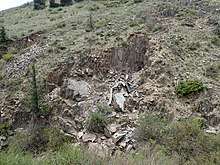Moppin Complex
The Moppin Complex is a Precambrian geologic complex found in the Tusas Mountains of northern New Mexico. It has not been directly dated, but is thought to be Statherian based on a minimum age of 1.755 Gya from radiometric dating of magmatic intrusions.
| Moppin Complex Stratigraphic range: Statherian | |
|---|---|
 Moppin Complex exposures along Placer Creek, New Mexico, USA | |
| Type | Complex |
| Underlies | Vadito Group |
| Lithology | |
| Primary | Metavolcanic rock |
| Other | Metasedimentary rock |
| Location | |
| Coordinates | 36.695°N 106.247°W |
| Region | Tusas Mountains, New Mexico |
| Country | |
| Type section | |
| Named for | Moppin Ranch |
| Named by | F. Barker |
| Year defined | 1958 |
 Moppin Complex (the United States)  Moppin Complex (New Mexico) | |
Description
The Moppin Complex consists mostly of chlorite shist (greenschist) and amphibolite,[1] but with lesser amounts of many other rock types, including metaconglomerate, phyllite, gneiss,[1] and muscovite schist.[2] Feldspathic schist[3] and banded iron formation[3][2] are also present. The banded iron is of the Algoma variety, formed by local volcanism rather than in the Great Oxidation Event.[4] Pillow lavas can be discerned at some locations[3] and the overall composition of the chlorite schist is that of altered basalt.[5] Major element and oxygen isotope ratios suggest the protolith was tholeiite.[6] Exposures of amphibolite along Cow Creek (36.642°N 106.109°W) are almost entirely very fine-grained hornblende and oligoclase.[7]
The complex crops out in the Tusas Mountains along a belt from American Creek (36.630°N 106.072°W) to Jawbone Mountain (36.743°N 106.244°W). Its base is nowhere exposed, but it is at least a few thousand meters (several thousand feet) thick.
The Moppin Complex is intruded by plutonic rocks, including the Maquinita Granodiorite, the trondjhemite of Rio Brazos[3], dikes and sills of the Burned Mountain Formation,[8], the Tusas Mountain Orthogneiss, and the Tres Piedras Orthogneiss.[8][9] The Maquinita Granodiorite has a uranium-lead radiometric age of 1.755 Gya, which constrains the minimum age of the Moppin Complex.[3] This makes the Moppin Complex one of the oldest known rock units in New Mexico.[2] It likely correlates with the Pecos Complex of the Santa Fe Mountains and the Gold Hill Complex of the Taos Mountains[10]
The complex is overlain by the Vadito Group. The lower part of the Vadito Group contains amphibolite bodies that may be transitional with the Moppin Complex.[11]
The unit is interpreted as a portion of an island arc accreted to the southern margin of Laurentia as part of the Yavapai Province between 1.8 and 1.755 Gya. The unit was intruded by the Tres Piedras Orthogneiss between 1.700 and 1.693 Gya as part of the transition from the Yavapai orogeny to the Mazatzal orogeny, and further deformed between 1.45 and 1.35 Gya.[12][13]
Economic geology
Gold has been mined in the Moppin Complex and comes from volcanogenic massive-sulfide deposits. Banded iron formation may amount to 100 million tons of low-grade iron ore, but this is not presently economically recoverable.[14]
History of investigation
The rock beds making up the Moppin Complex were originally named the Hopewell Series in by Evan Just in 1937 during an investigation of pegmatites in the Tusas Mountains.[15] However, this name was already in use, and the unit was renamed the Moppin metavolcanic series by Fred Barker in 1958.[8] With the recognition that the lithology was more diverse, including metasedimentary as well as metavolcanic rock, the unit was renamed as the Moppin Complex by Bauer and Williams in their sweeping revision of the stratigraphy of northern New Mexico Proterozoic rock units in 1989.[10]
 Greenschist of the Moppin Complex. This is the predominant rock type in the complex.
Greenschist of the Moppin Complex. This is the predominant rock type in the complex. Feldspathic schist of the Moppin Complex on Hopewell Ridge.
Feldspathic schist of the Moppin Complex on Hopewell Ridge.
Notes
- Barker 1958, p.10
- McLemore 2011, p.380
- Bauer and Williams 1989, p.47
- Fulp and Lee 1981
- Barker 1958, p.16
- Barker and Friedman 1974
- Barker 1958, p.17
- Barker 1958, p.14
- Davis et al. 2011, p.180
- Bauer and Williams 1989, p.46
- Bauer and Williams 1989, p.48
- Davis et al. 2011
- Damiel et al.' 2016
- McLemore 2011, p.384
- Just 1937, p.21
References
- Barker, Fred (1958). "Precambrian and Tertiary geology of Las Tablas quadrangle, New Mexico" (PDF). New Mexico Bureau of Mines and Mineral Resources Bulletin. 45.
- Barker, Fred; Friedman, Irving (1974). "PRECAMBRIAN METAVOLCANIC ROCKS OF THE TUSAS MOUNTAINS, NEW MEXICO: MAJOR ELEMENTS AND OXYGEN ISOTOPES". New Mexico Geological Society Field Conference Series (25): 115–117. Retrieved 8 May 2020.
- Bauer, Paul W.; Williams, Michael L. (August 1989). "Stratigraphic nomenclature ol proterozoic rocks, northern New Mexico-revisions, redefinitions, and formaliza" (PDF). New Mexico Geology. 11 (3). Retrieved 15 April 2020.
- Damiel, Christopher G.; Andronicos, Christopher L.; Aronoff, Ruth F. (2016). "Regional Al2SiO5 triple-point metamorphic rocks of northern New Mexico; A field trip to honor the career contributions od Lincoln Hollister to petrology and tectonics". The Geological Society of America Field Guide Series. 44: 201–229. ISBN 9780813700441.
- Davis, Peter; Williams, Mike; Karlstrom, Karl (2011). "Structural evolution and timing of deformation along the Proterozoic Spring Creek shear zone of the northern Tusas Mountains, New Mexico" (PDF). New Mexico Geological Society Field Conference Series. 62: 177–190.
- Fulp, Michael S.; Woodward, Lee A. (August 1981). "Precambrian metallic mineralization in New Mexico" (PDF). New Mexico Geology. 3 (3). Retrieved 8 May 2020.
- Just, Evan (1937). "Geology and Economic Features of the Pegmatites of Taos and Rio Arriba Counties, New Mexico" (PDF). New Mexico School of Mines Bulletin (13).
- McLemore, Virginia T. (2011). "Geology and mineral resources in the Hopewell and Bromide No. 2 districts, northern Tusas Mountains, Rio Arriba County, New Mexico" (PDF). New Mexico Geological Society Field Conference Series. 62: 379–388.